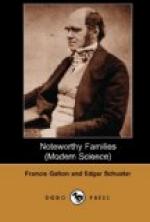Kinsfolk may be divided into direct ancestry, collaterals of all kinds, and direct descendants. As regards the direct ancestry, each person has one and only one ancestor in each specific degree, one fa, one fa fa, one me fa, and so on, although in each generic degree it is otherwise; he has two grandfathers, four great-grandfathers, etc. With collaterals and descendants the average number of fertile relatives in each specified degree must be stationary in a stationary population, and calculation shows that number is approximately one. The calculation takes no cognizance of infertile relatives, and so its results are unaffected by the detail whether the population is kept stationary by an increased birth-rate of children or other infertiles, accompanied by an increased death-rate among them, or contrariwise.
The exact conclusions were ("Nature,” September 29, 1904, p. 529), that if 2_d_ be the number of children in a family, half of them on the average being male, and if the population be stationary, the number of fertile males in each specific ancestral kinship would be one, in each collateral it would be d-1/2, in each descending kinship d. If 2_d_ = 5 (which is a common size of family), one of these on the average would be a fertile son, one a fertile daughter, and the three that remained would leave no issue. They would either die as boys or girls or they would remain unmarried, or, if married, would have no children.
The reasonable and approximate assumption I now propose to make is that the number of fertile individuals is not grossly different to that of those who live long enough to have an opportunity of distinguishing themselves. Consequently, the calculations that apply to fertile persons will be held to apply very roughly to those who were in a position, so far as age is concerned, to achieve noteworthiness, whether they did so or not. Thus, if a group of 100 men had between them 20 noteworthy paternal uncles, it will be assumed that the total number of their paternal uncles who reached mature age was about 100, making the intensity of success as 20 to 100, or as 1 to 5. This method of roughly evading the serious difficulty arising from ignorance of the true values in the individual cases is quite legitimate, and close enough for present purposes.
CHAPTER VIII.—NUMBER OF NOTEWORTHY KINSMEN IN EACH DEGREE.
The materials with which I am dealing do not admit of adequately discussing noteworthiness in women, whose opportunities of achieving distinction are far fewer than those of men, and whose energies are more severely taxed by domestic and social duties. Women have sometimes been accredited in these returns by a member of their own family circle, as being gifted with powers at least equal to those of their distinguished brothers, but definite facts in corroboration of such estimates were rarely supplied.




